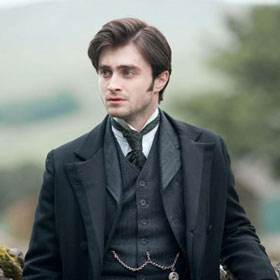The Woman in Black

3/5
Let’s take the elephant out of the room: Daniel Radcliffe is not Harry Potter, at least not anymore. Radcliffe has enjoyed success, and attracted some controversy along the way, notably his appearances outside of the Potter universe nude on The West End. Now with the release of The Woman in Black, he’s starring in his first non-wizarding motion picture. Granted, we’ve spent a lot of time with Radcliffe, watching him grow up and mature as an actor, so it’s hard for us to separate the man from the role; it’s an albatross Radcliffe, and other child actors, must bear. However, an adult Radcliffe proves in this spooky, supernatural drama that he’s got more than muttonchops and some serious Victorian duds.
The newest (in a long time) from the venerable horror imprint, Hammer, and an adaptation of the Susan Hill novel of the same name, The Woman in Black tells the story of Arthur Kipps, a young solicitor and single father whose wife died in childbirth. Kipps is depressed, despondent and performing poorly on the job. In order to have him prove his dedication to the firm, Kipps' boss sends him out to a rural village in damp, foggy northern England to see to the sale of an estate formerly belonging to a recently deceased couple. Not surprisingly – given that this is Hammer Horror – the residents of the village are less than welcoming. The room Kipps has booked is suddenly unavailable. Parents rush their children inside when he walks by. Everyone in town begs him to return to London. It’s almost as if they have something to hide!
The only warm greeting Kipps gets comes from the wealthy couple, Sam Daily (Ciaran Hines) and his wife Elizabeth (Janet McTeer), who in an effort to replace her dead child has taken to bringing dogs to the dinner table. Sam, a decidedly logical and anti-superstitious man, offers to assist Kipps in his duties and takes him out to the Eel Marsh House, a sinister mansion isolated and cut off from the mainland during high tide. Once there, Kipps begins to unravel the story of a young boy’s death and encounters a host of strange apparitions, including a strange woman in black standing in the graveyard. It turns out that, according to the local superstition, anybody who sees the woman will bring bad luck to the children of the village – in the form of death.
Radcliff makes decent work of the somber Englishman, but only in the sense that the movie works through him. Each time Kipps sees something spooky – a self-rocking chair, wind-up toys that play on their own, a child rising from the marsh – his expression is one of studiousness, not abject fear. Of course Kipps' arrival is the inciting action for The Woman in Black, but the character is never actually imposed onto the environment. Rather, he witnesses it. We know that his job is on the line, but that doesn’t seem a sufficient enough reason to endure the all that terror. More reasonable is the fact that Kipps’ four-year-old son is on his way to meet his father in the doomed village. At least this gives us a ticking clock. But Kipps' backstory – his deceased wife, his depression and suicidal thoughts – doesn’t come into play. Only occasionally, when confronted with the unexplainable, do we see a flash of mad awareness in his eyes. The rest of time he wanders around the house and the town like a sleepwalker, unaffected, and when he finally takes the initiative, his plan is an absurd shot in the dark.
Much better is Hines’ delusional Sam Daily, McTeer as his epileptic/psychic wife, and if you consider the setting a character, the dreary, wet English landscape, which is put to good use by cinematographer, Tim Maurice-Jones. The Dailys proffer a practical example of the town's curse. Sam refuses to believe that the woman in black is anything but a silly ghost story. He tells Kipps not to go chasing shadows, which would seem like sound advice if we weren’t so sure he was wrong. Sam is admirable in his denial and stoicism. He’s a modern man living in a world of blind superstition (he owns the only car in the village), which makes it more impressive when he’s face-to-face with his own demons, emphasizing the tenuous bond between what is supposed reality and the spiritual world. McTeer plays an excellent batty, old Mrs. Daily. Her long, frazzled gray hair, her proclivity towards babying her pups and her tendency to communicate with her dead son make for an intoxicating mixture of harmless insanity and foreboding prophecy.
While it takes a good amount of screen time for Kipps to piece together the puzzle, The Woman in Black moves along at a pace more intense than brisk, each atmospheric second jam packed with a quiet tension. It plays out nicely that director James Watkins opted out of the blood-and-gore approach in favor of psychological scares. Most of the movie is practically built on a wide shot of Radcliffe’s scrubby Londoner mug and the blurry shape of a cloaked woman creeping about in the background. After awhile this trick becomes predictable, but not so expected that each time it is exhibited it doesn’t elicit goose bumps or a jump. Bolstered by the cobweb bedecked and candle-lit setting of the house, The Woman in Black builds pressure expertly, reminiscent of classic horror movies, and when each blessed release comes it’s only a short time before the next builds. The effect is a consistently cagey movie, one that will keep you on the edge of the seat during the entirety of the film
RELATED ARTICLES
Get the most-revealing celebrity conversations with the uInterview podcast!





Leave a comment